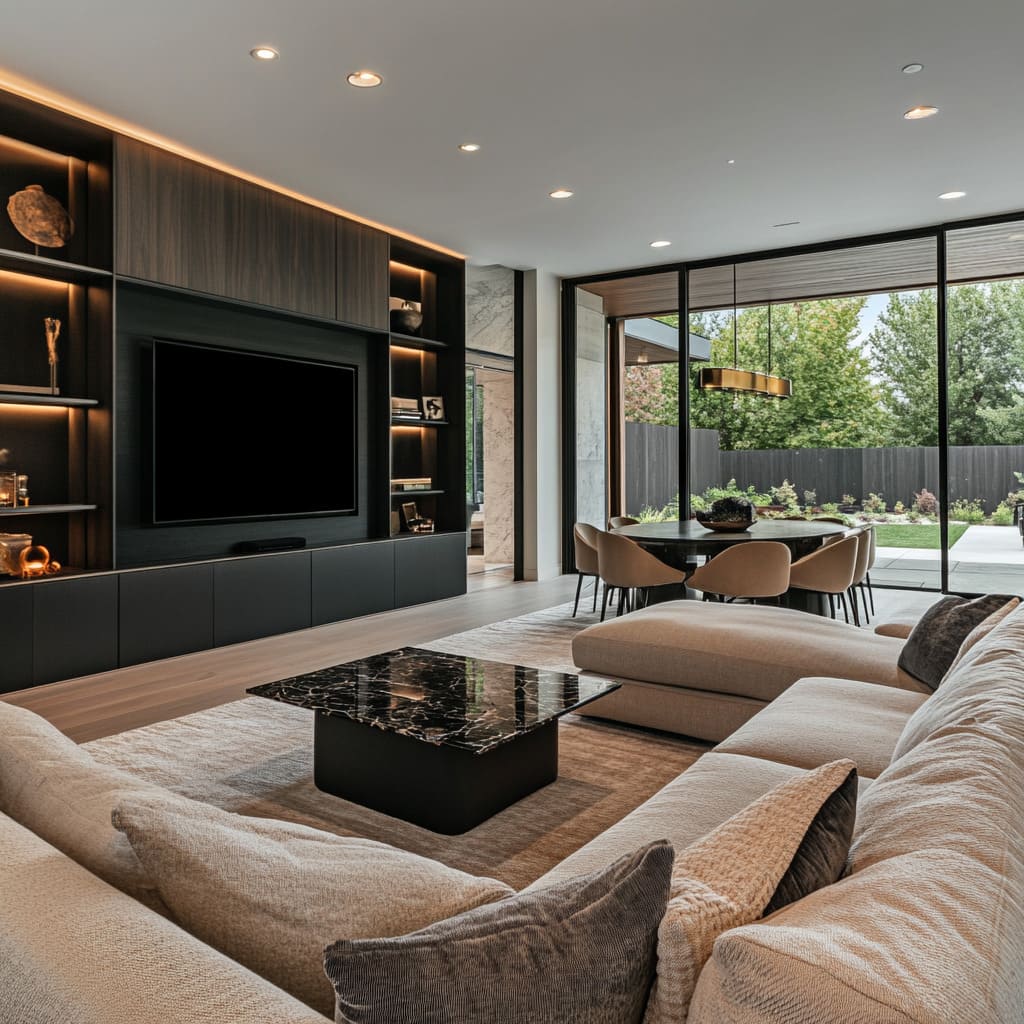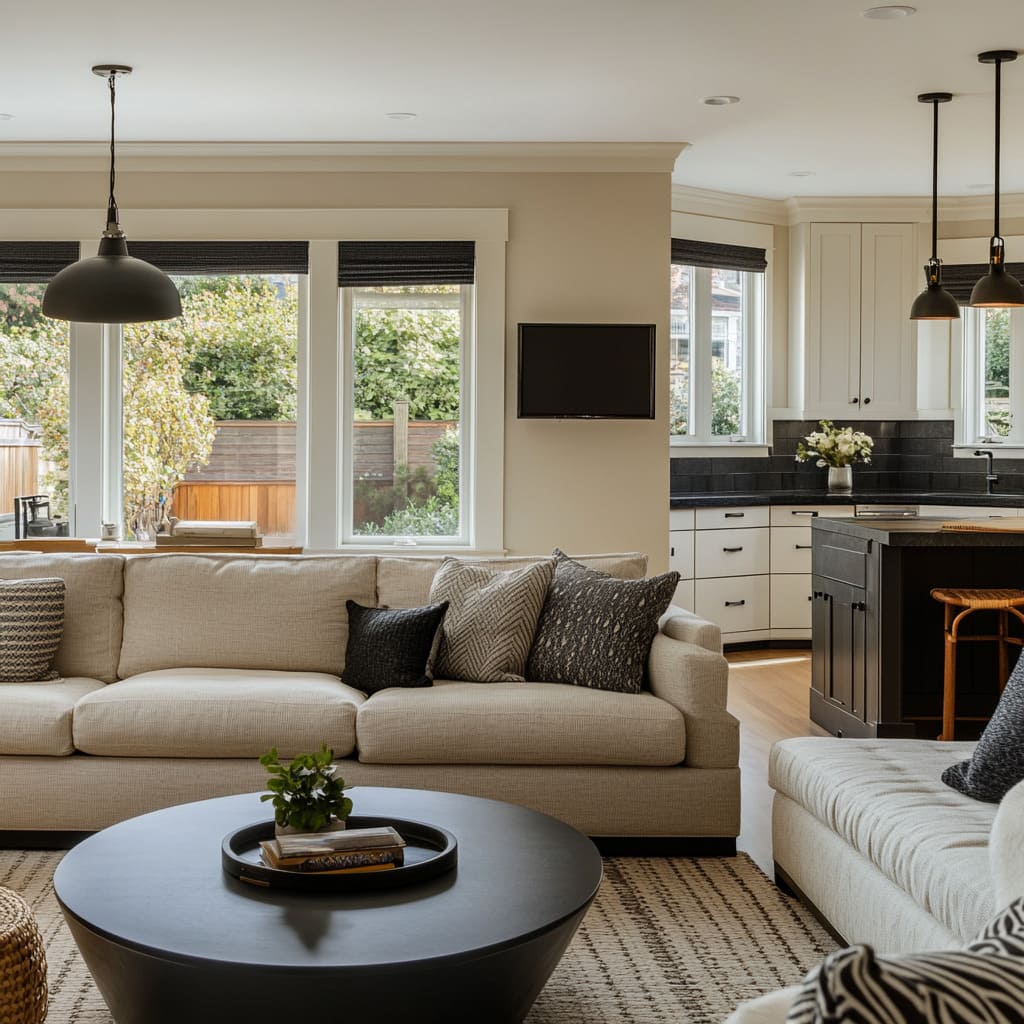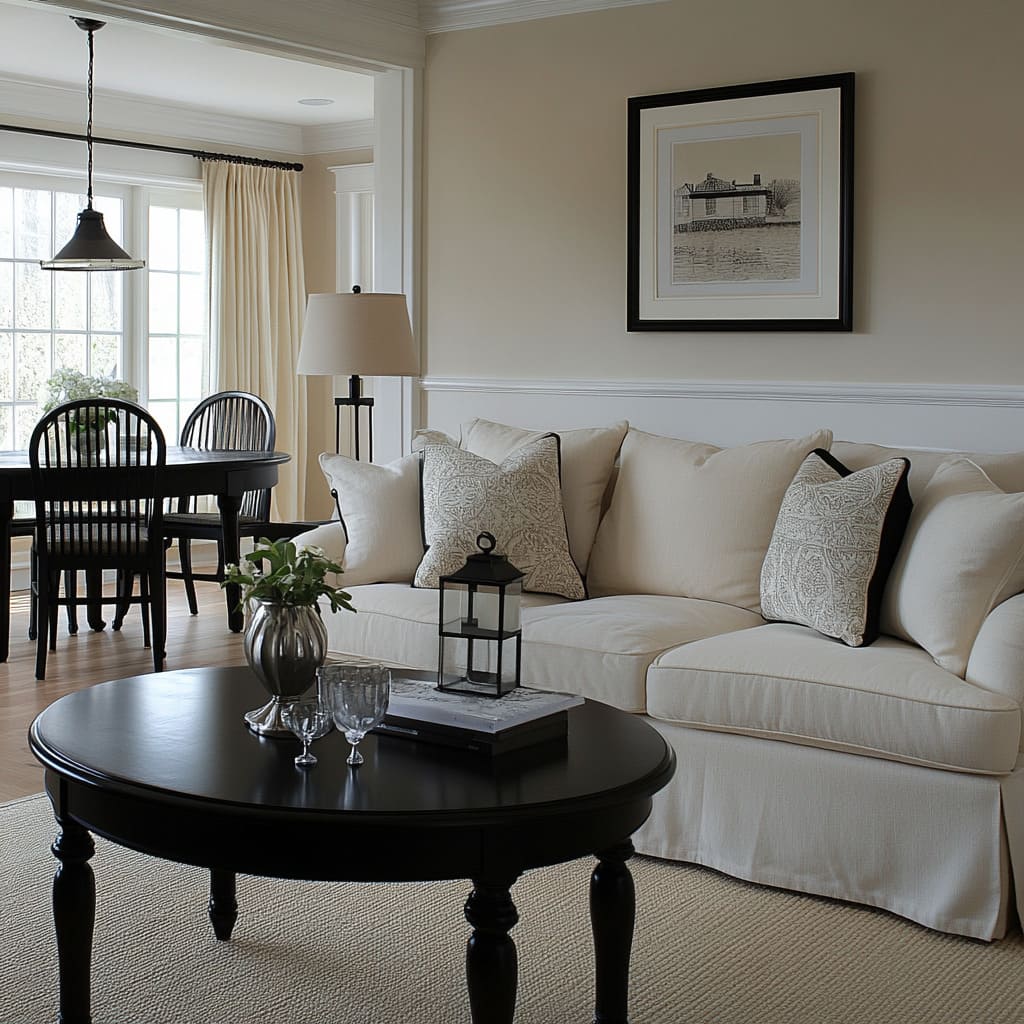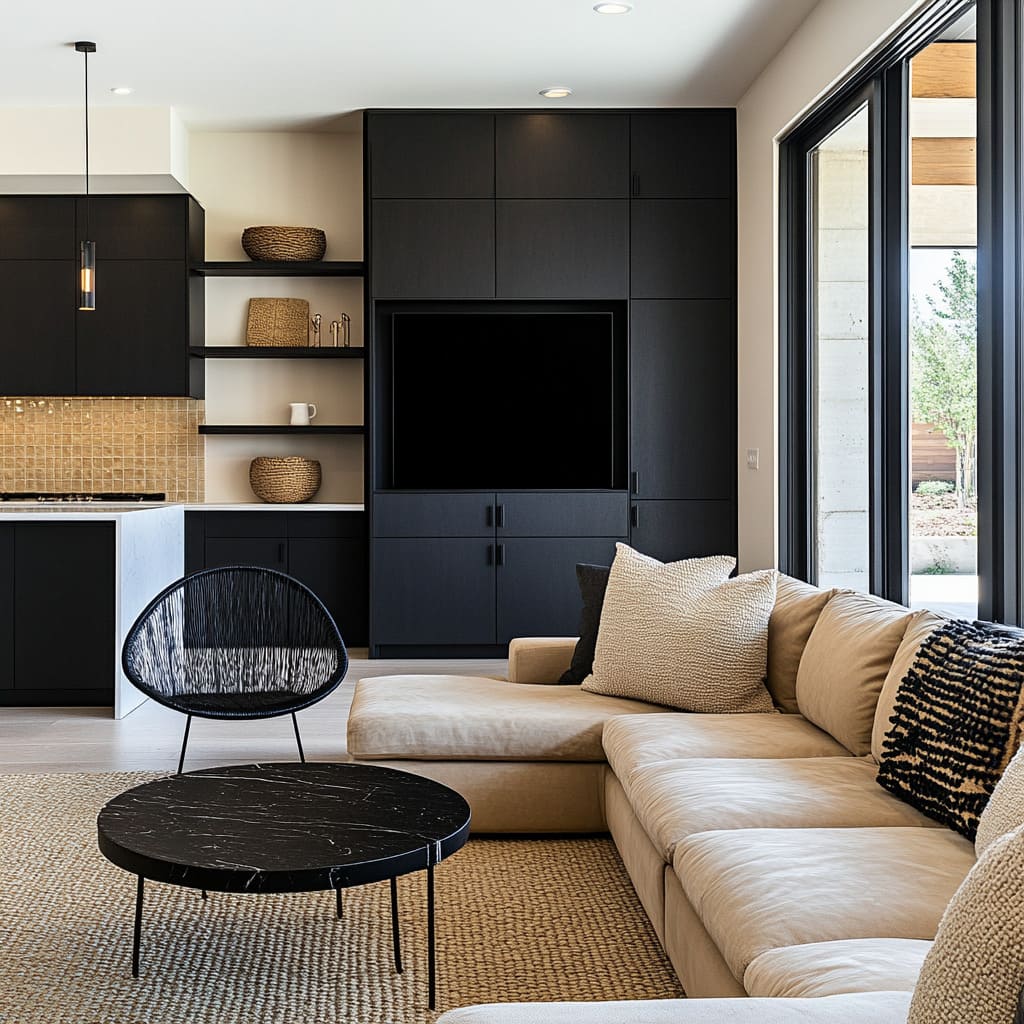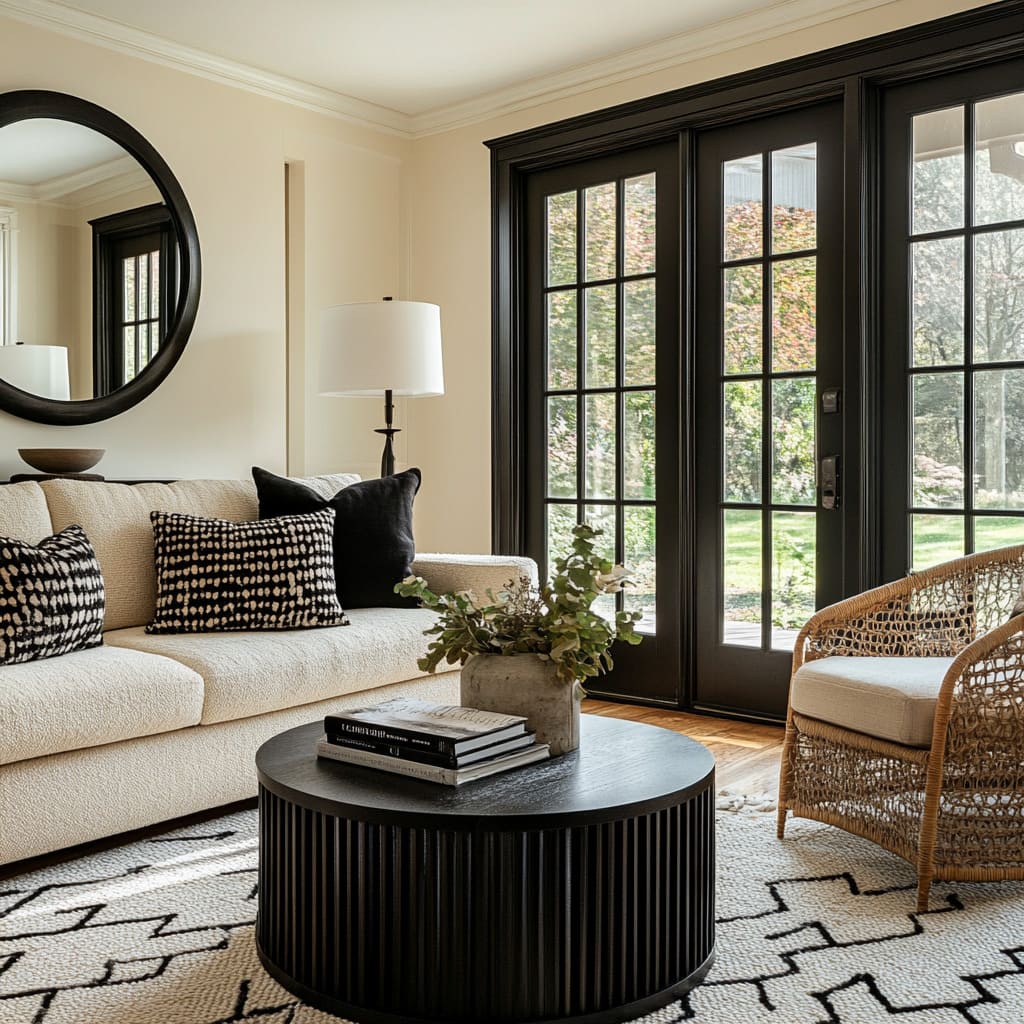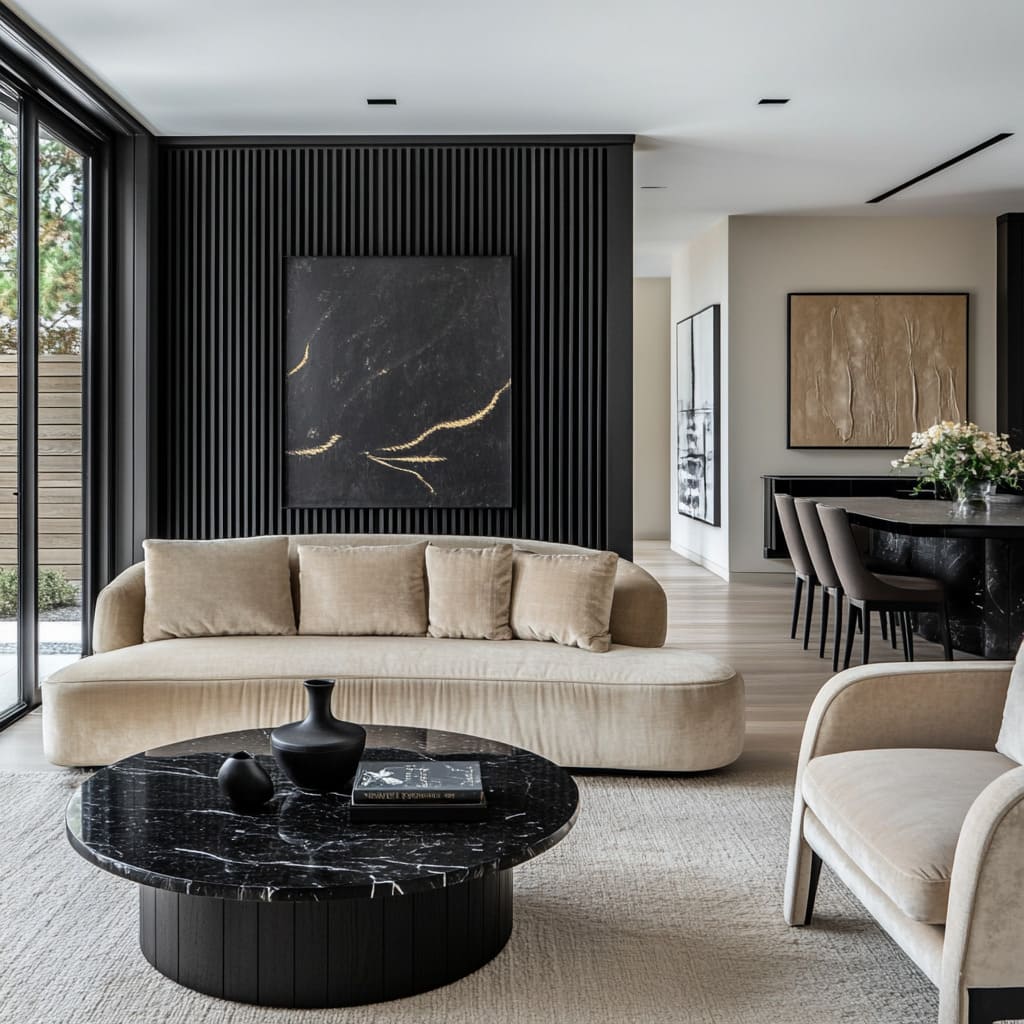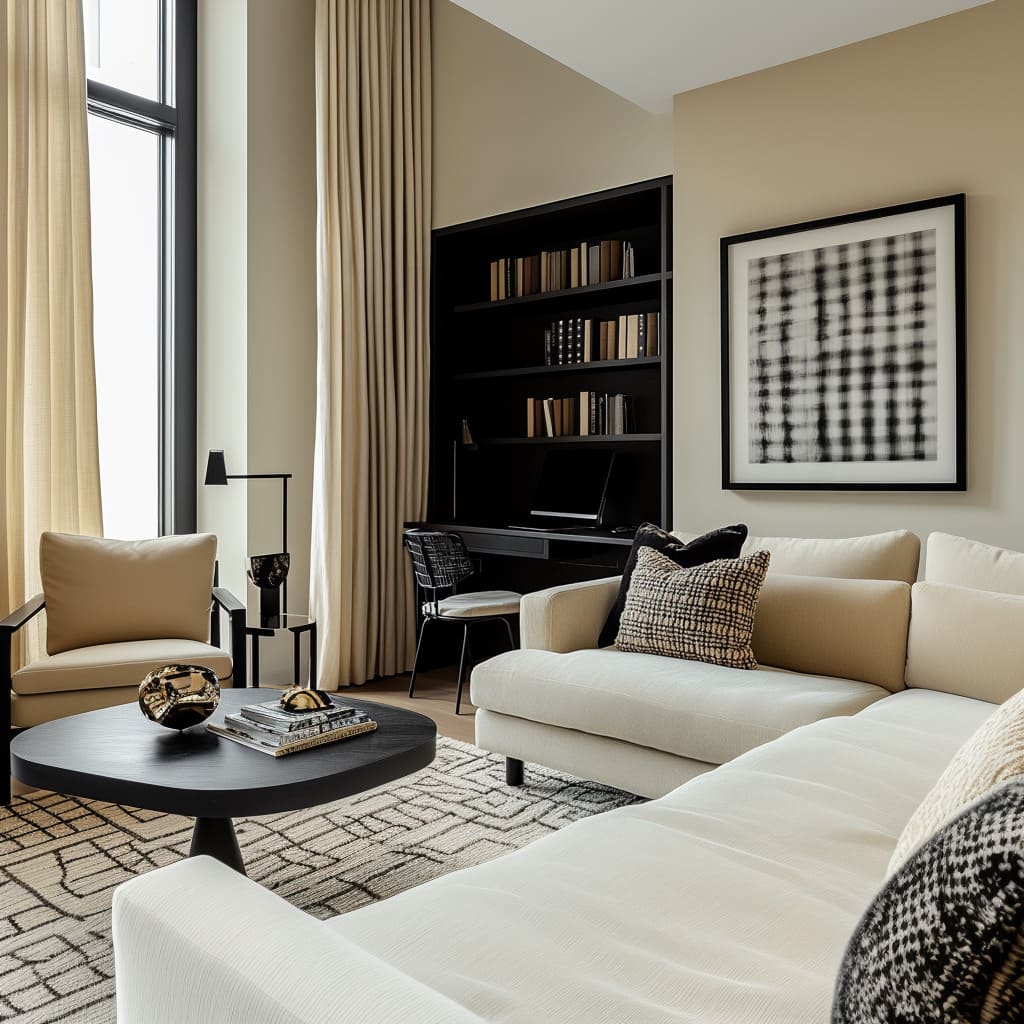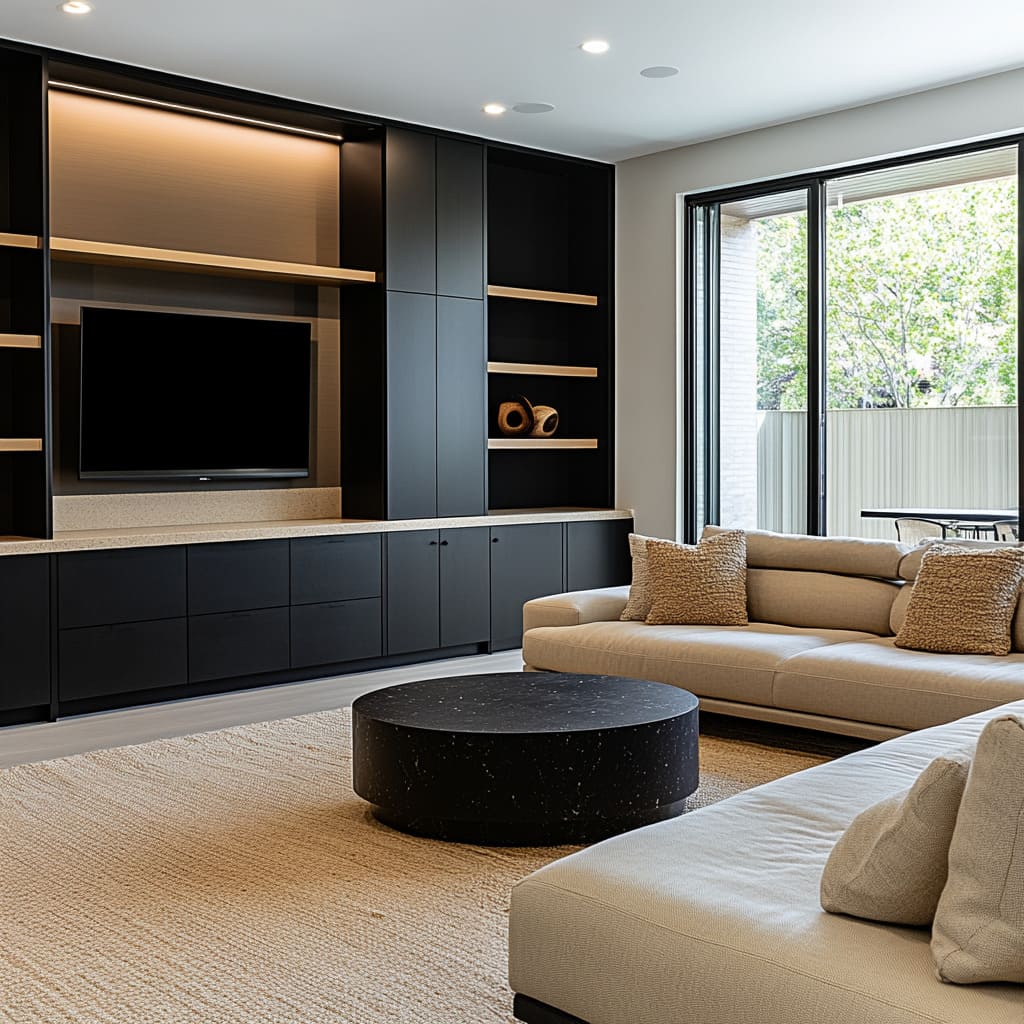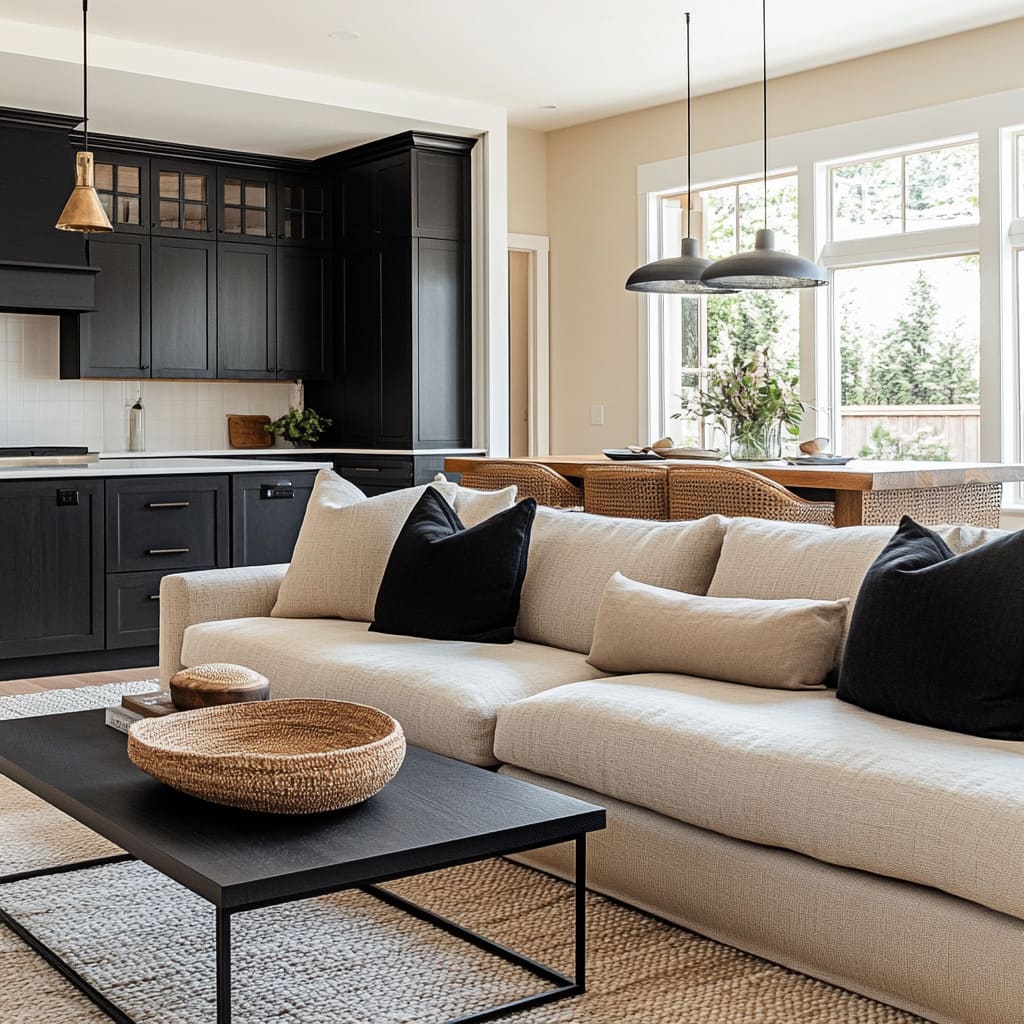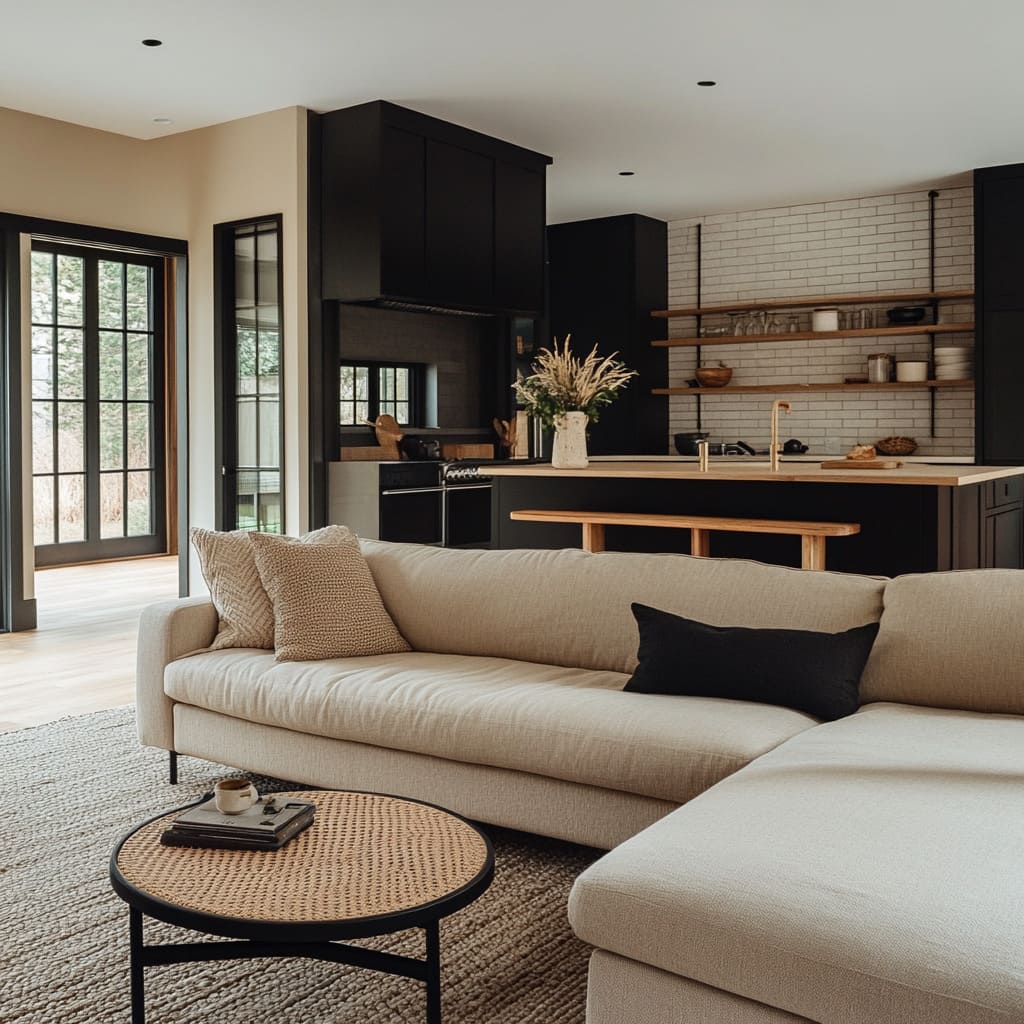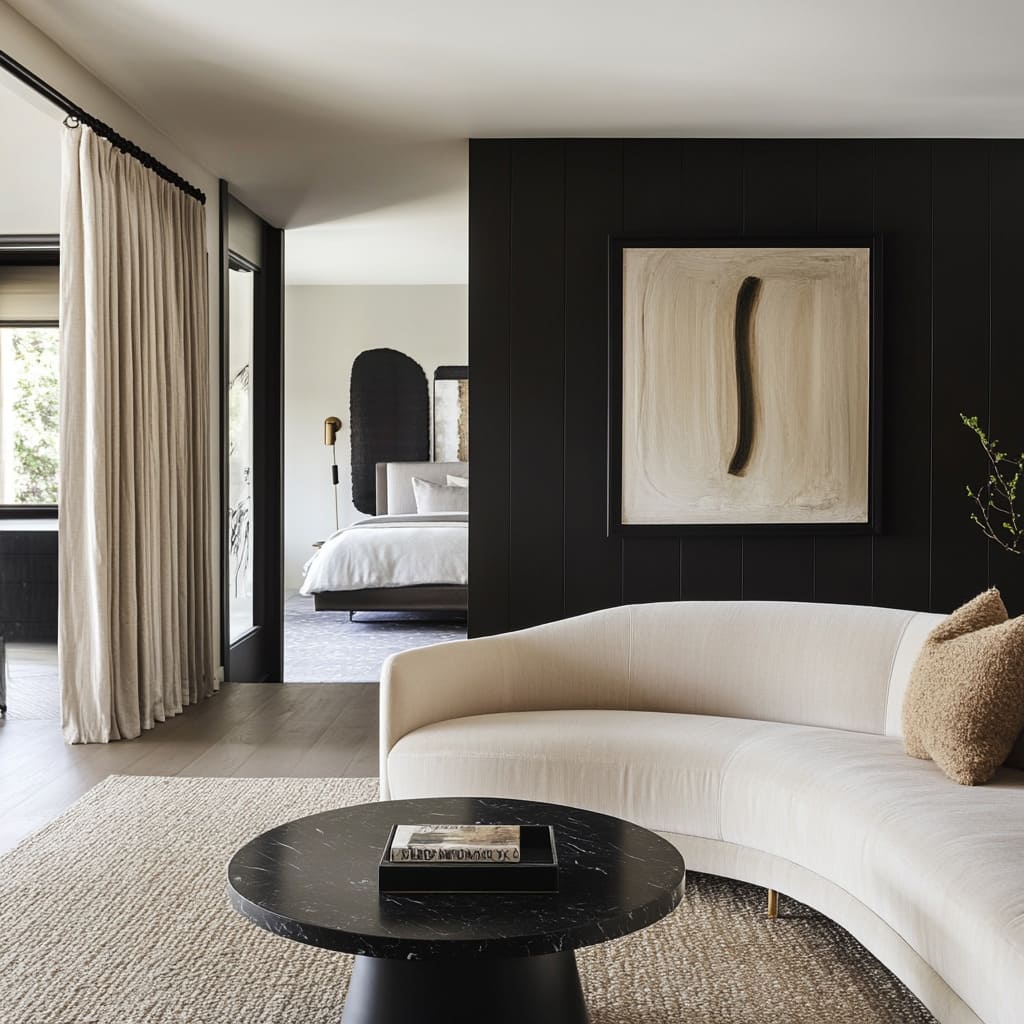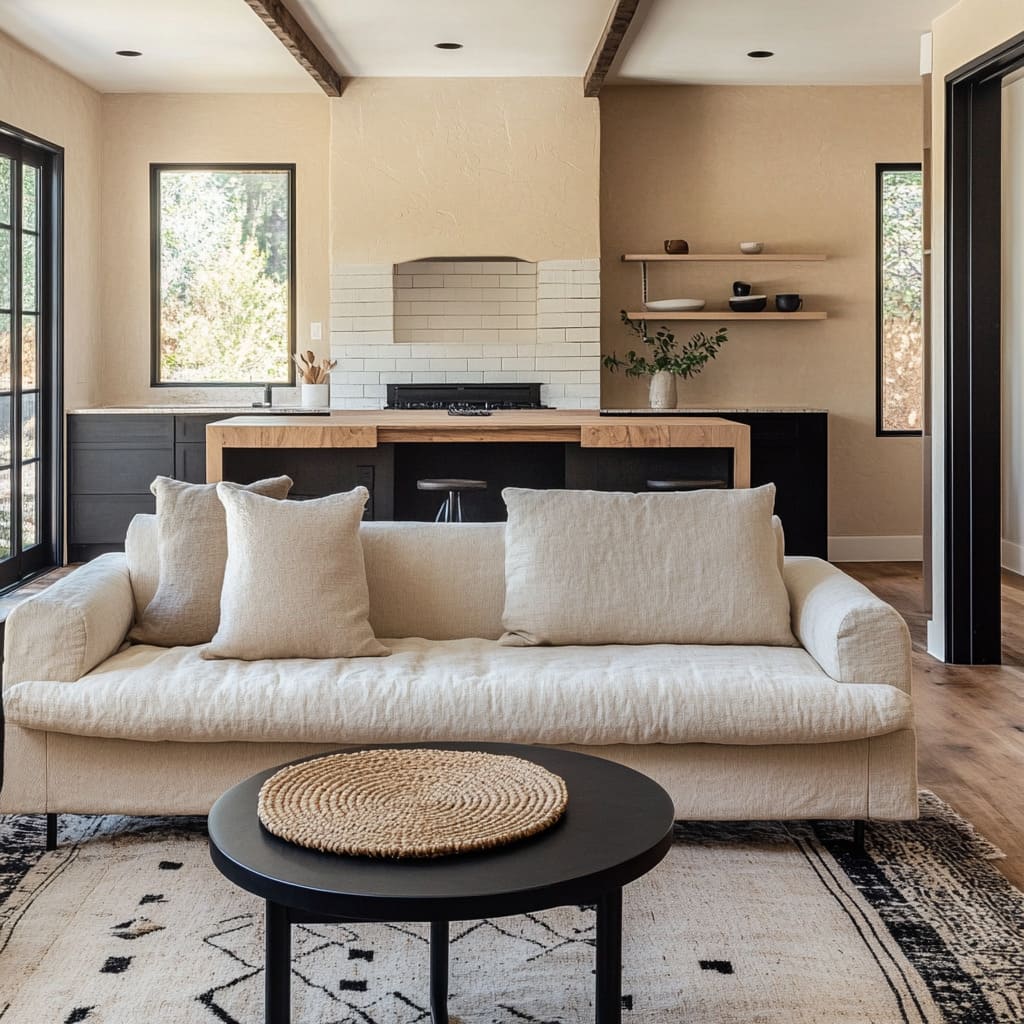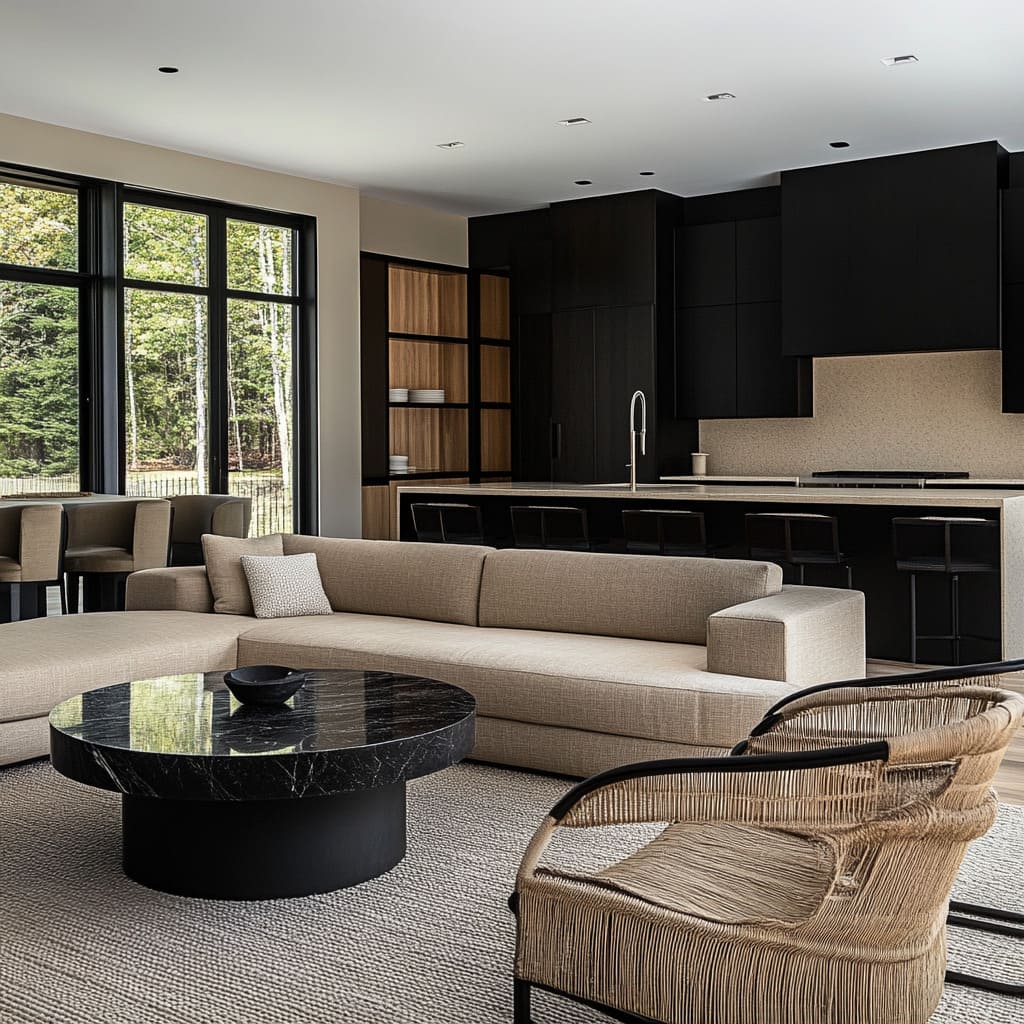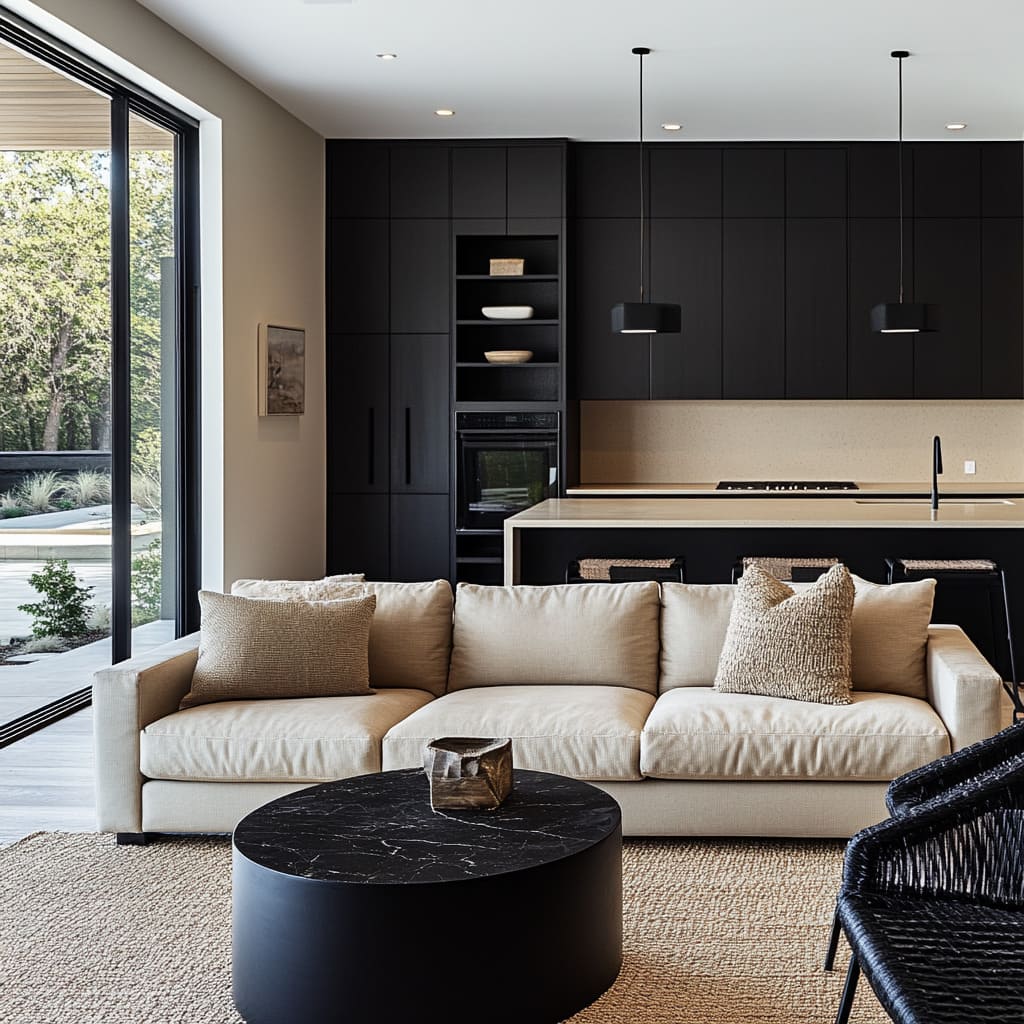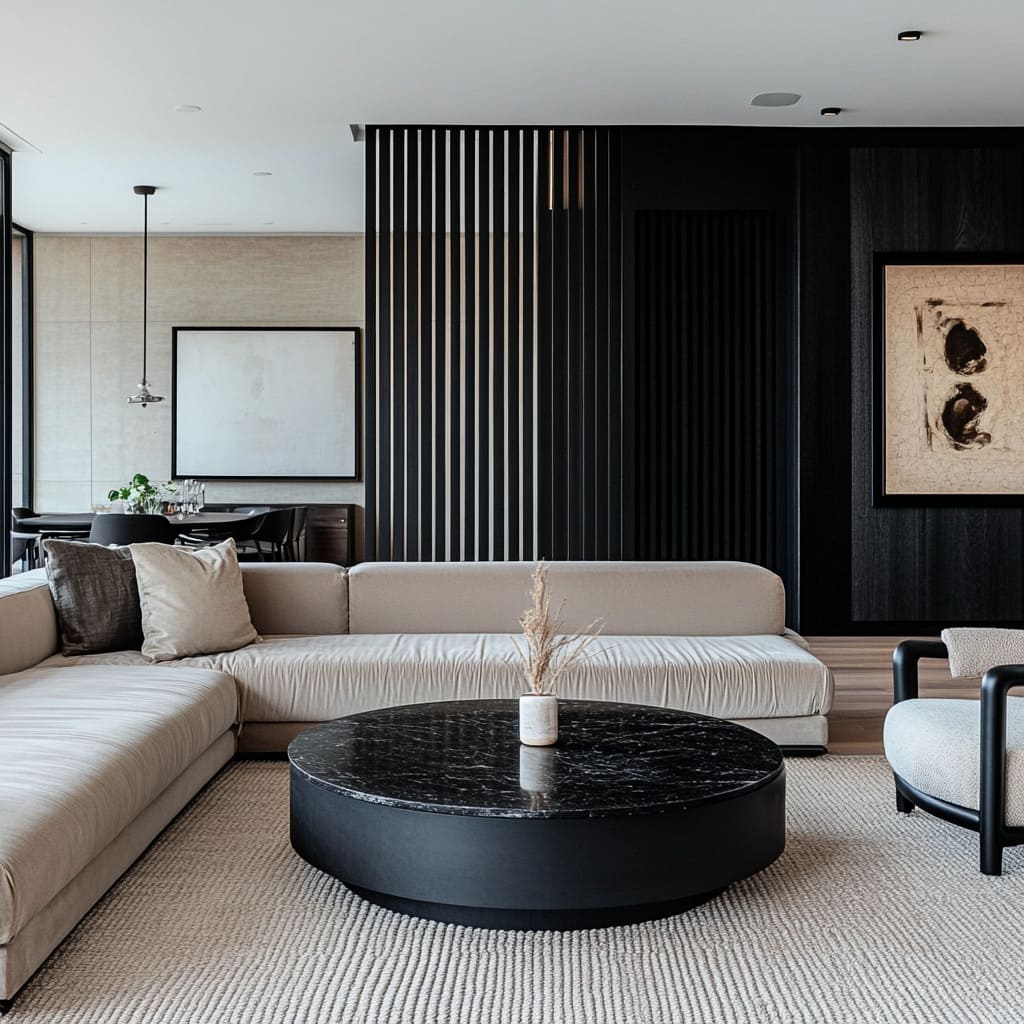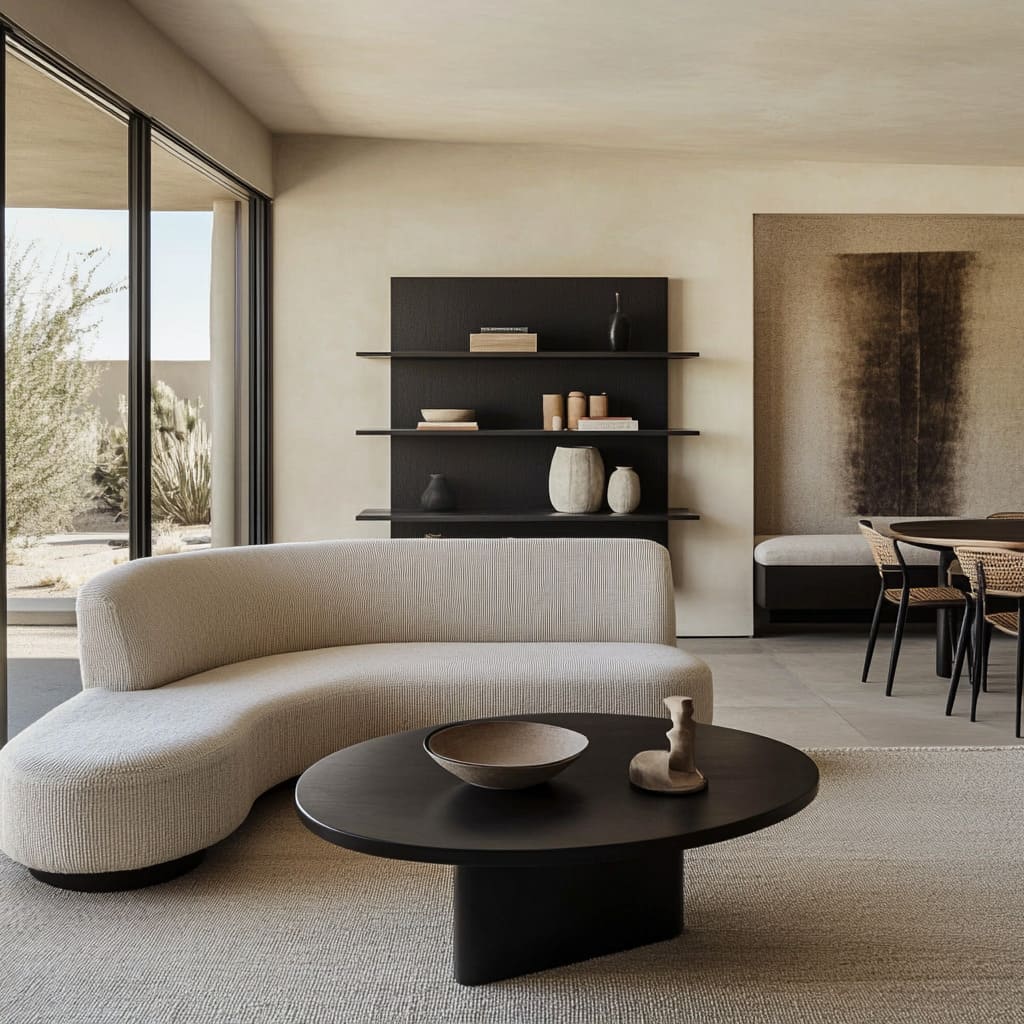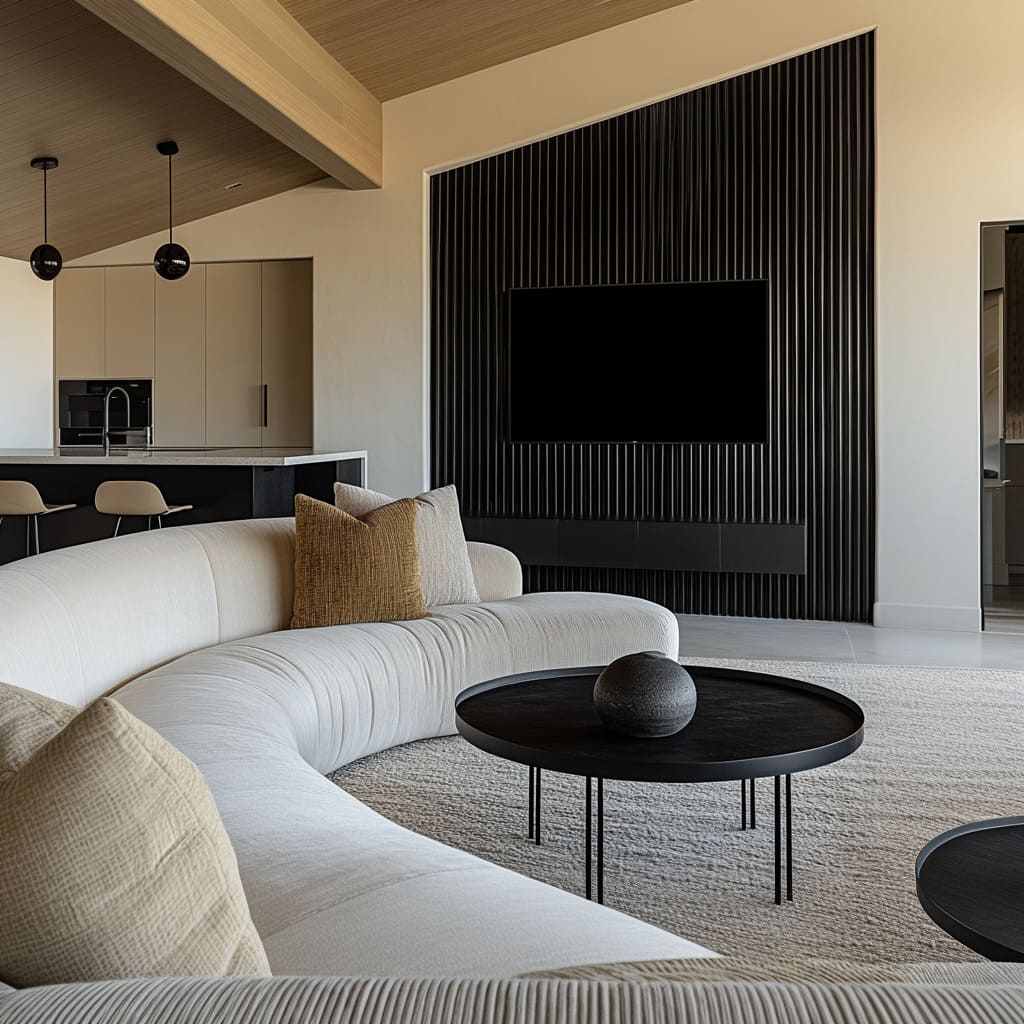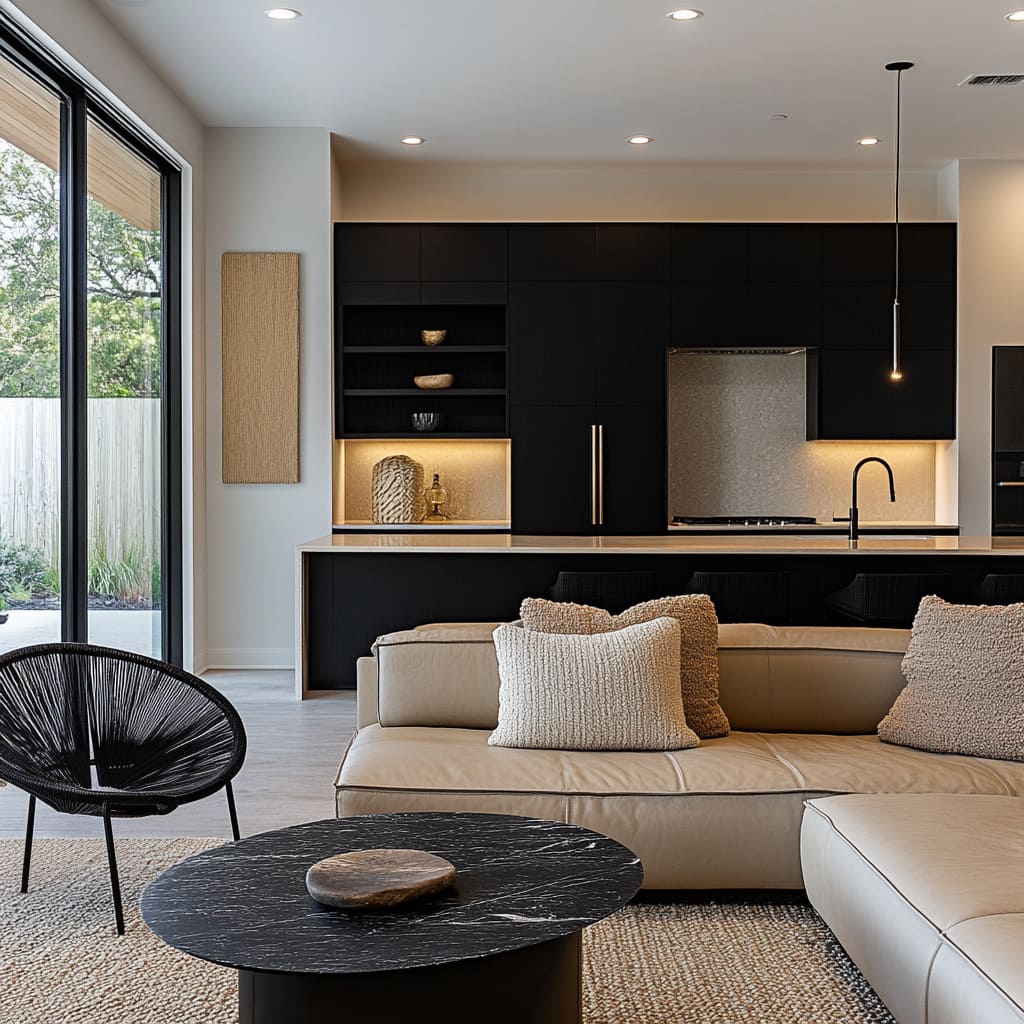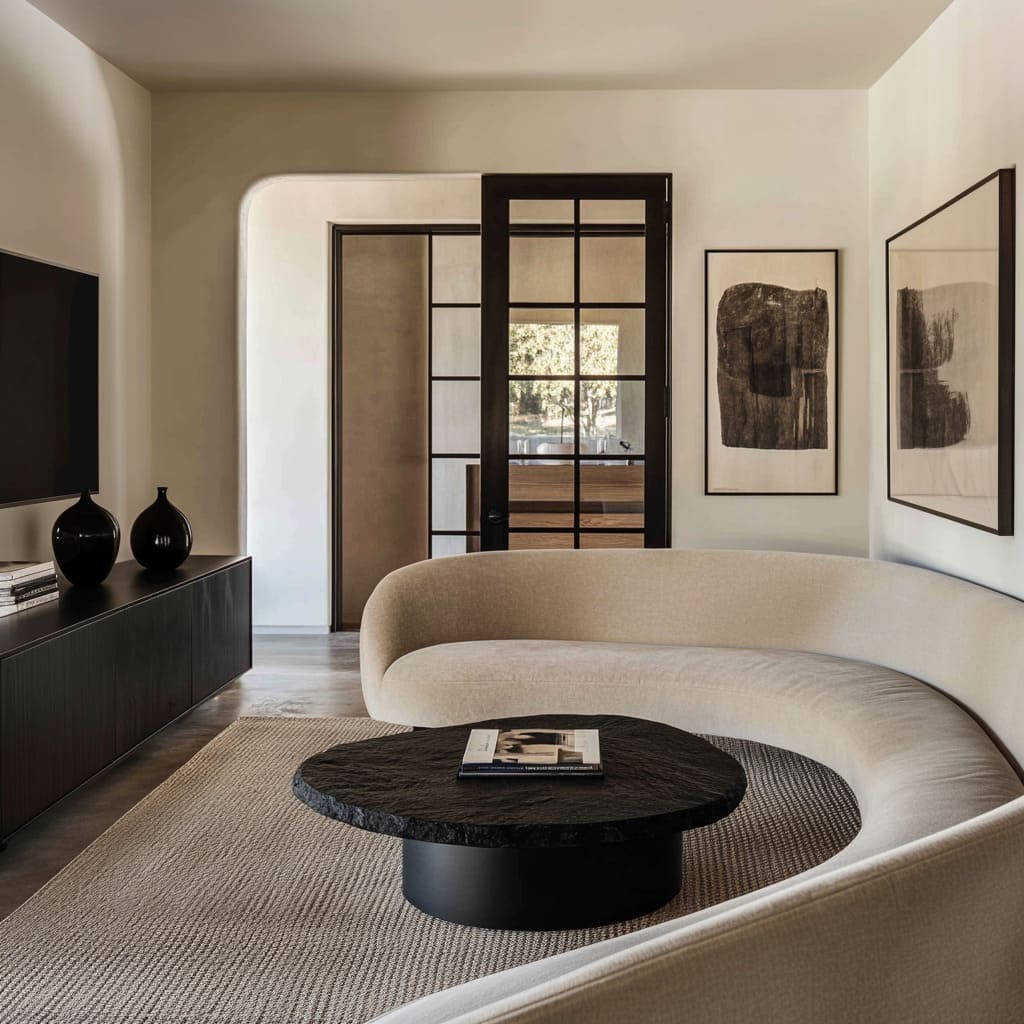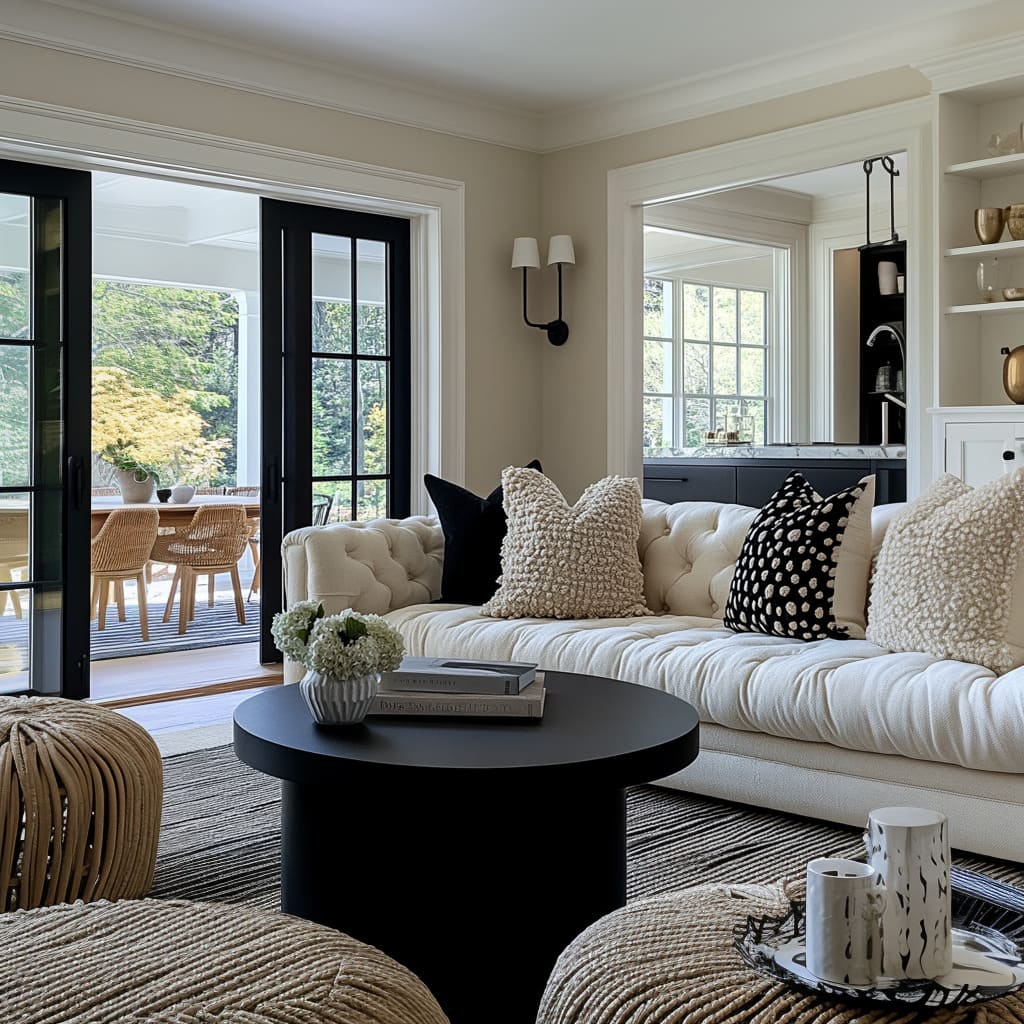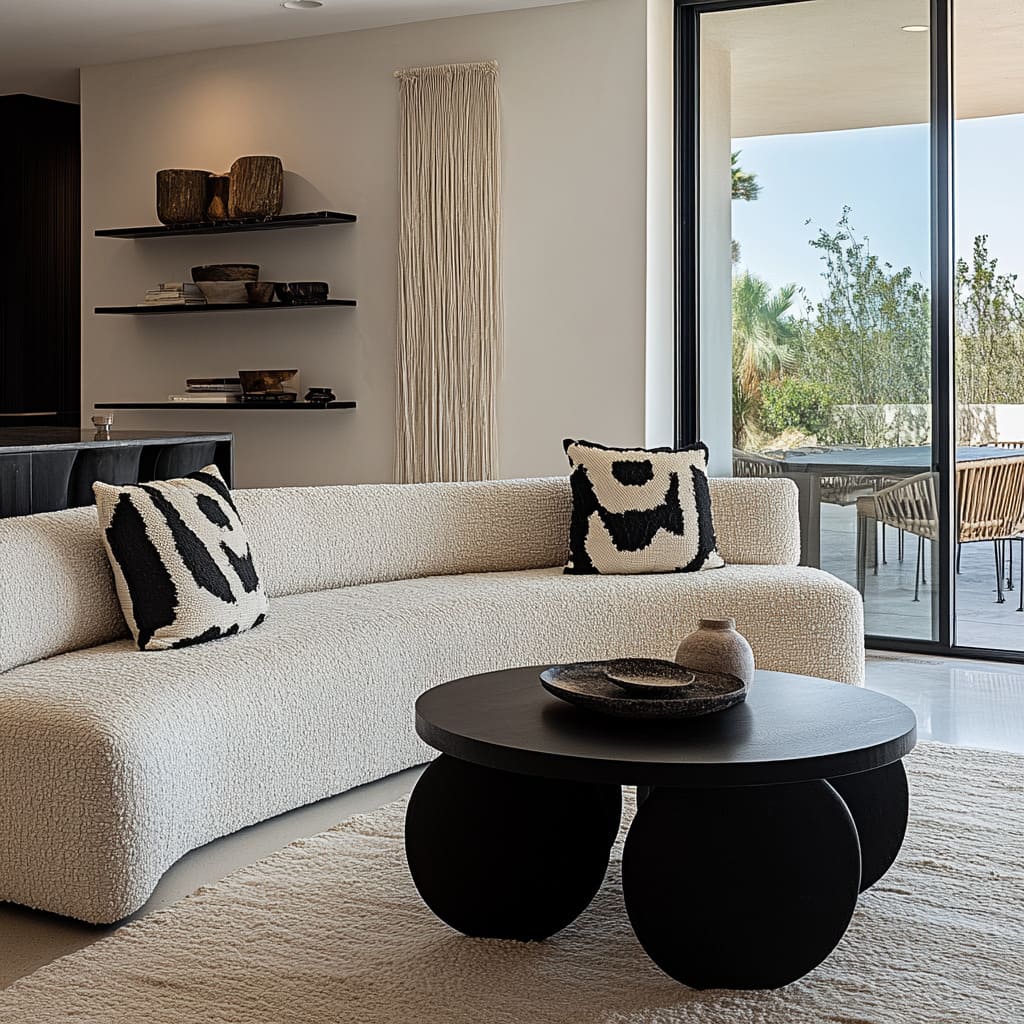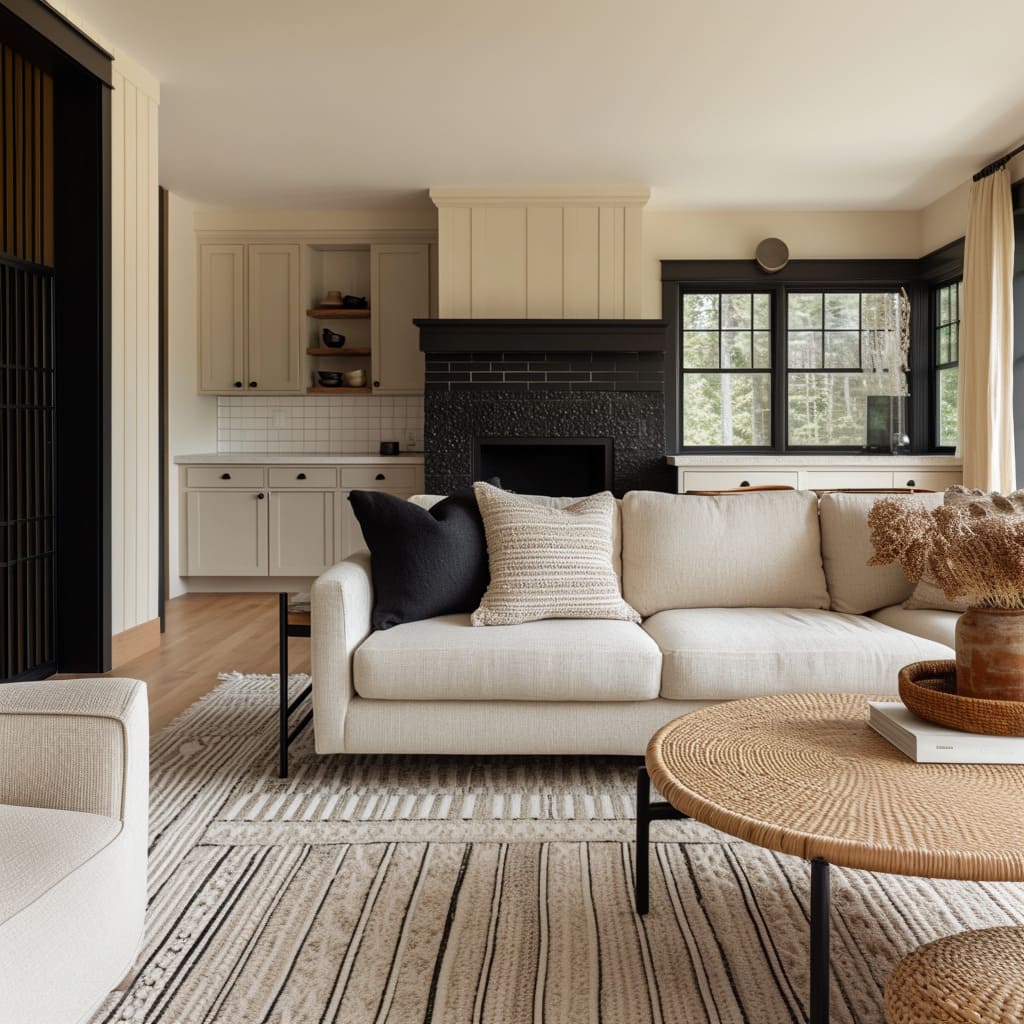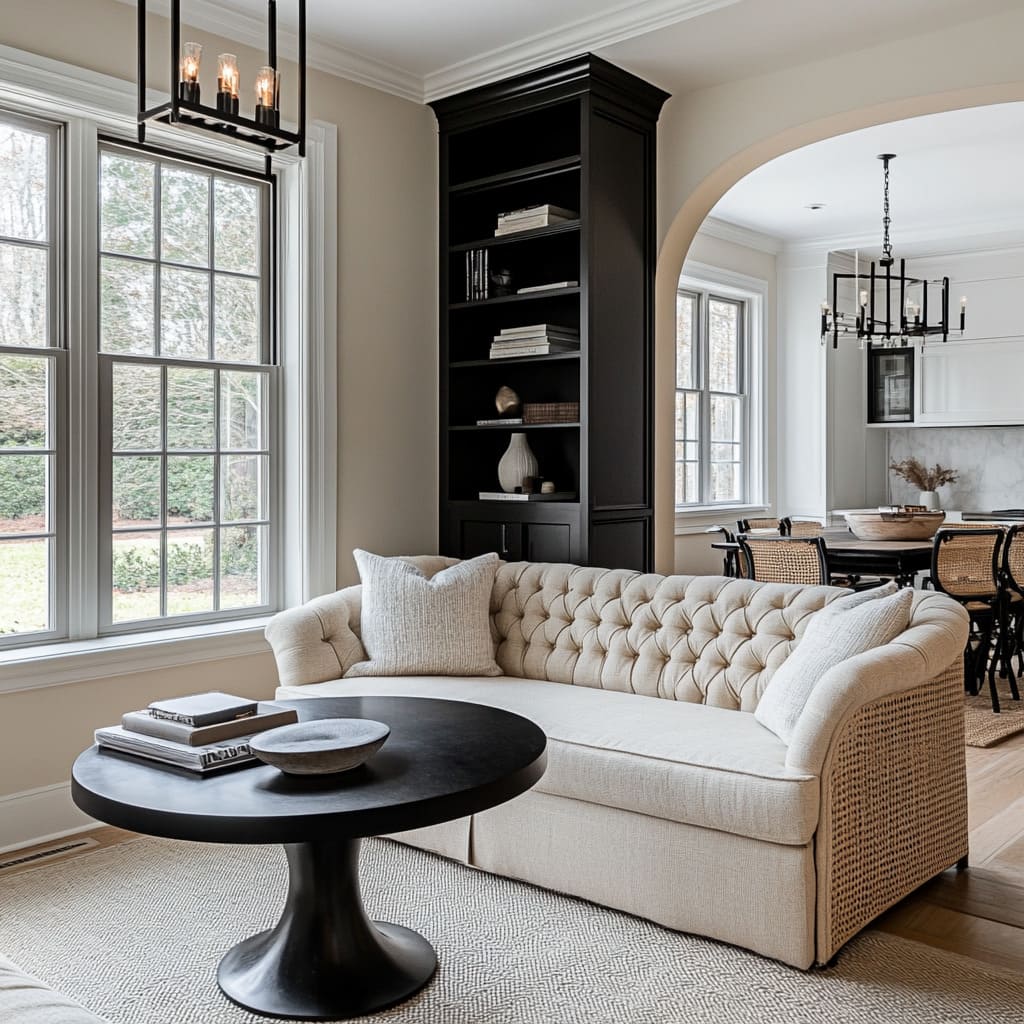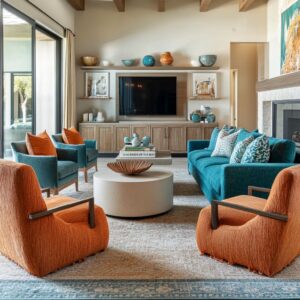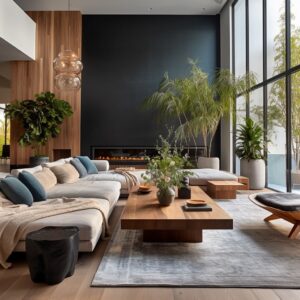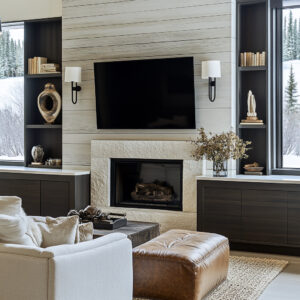Creating a beige and black living room is about the way these shades interact through materials, textures, and architectural details to build a space that feels intentional and inviting. While some designs lean bold with deep contrasts, others soften the palette with layered neutrals, natural elements, and subtle patterns.
This guide goes beyond simple color coordination, diving into the nuances that make this combination stand out. From layout and furniture placement to lighting and decor choices, every element plays a role in shaping the atmosphere.
Whether you’re aiming for a cozy, rustic aesthetic or a sleek, contemporary feel, understanding how to balance these tones is key to getting the right look.
Color Balancing and Subtle Tonal Shifts
A beige black living room doesn’t work if the colors feel flat or predictable. The key to making this combination feel intentional is in the subtle layering of shades and finishes.
Beige isn’t a single tone—it spans a spectrum from warm cream to muted ecru, and using a mix of these variations creates depth that prevents the space from looking one-dimensional. The same principle applies to black.
Instead of sticking to one finish, designers use a mix of matte, glossy, textured, and natural materials to add richness. A matte black wall can act as a bold anchor, while glossy black marble or polished metal accents introduce contrast without overwhelming the space.
Textured black brick, woven fabrics, or slatted wood in a deep charcoal tone can introduce even more variation, making the room feel thoughtfully layered.
To get this right, avoid using beige in just one texture. A linen-upholstered sofa paired with a high-pile wool rug and soft cotton curtains will create a balanced composition.
Meanwhile, black details should feel intentional rather than overpowering—whether that’s through sleek cabinetry, statement lighting, or sculptural decor pieces. The contrast between light and dark is what makes this style stand out, but the success lies in how smoothly these elements transition from one to the next.
Contrasts and Surface Finishes
A beige-and-black color scheme thrives on contrast, but what makes a space truly stand out is the interplay between different textures. Instead of relying on color alone, designers use surface finishes to create visual depth and balance.
In many beige and black living room ideas, soft woven fabrics and organic materials prevent dark cabinetry, walls, or furniture from feeling too harsh. This contrast is often seen in the mix of jute rugs, boucle upholstery, and linen curtains against sleek black metal, stone, or wood.
A black accent wall with vertical paneling adds structure, while a plush beige rug softens the look. Even in minimal spaces, the combination of rough and smooth elements ensures the room feels inviting rather than stark.
Stone surfaces, particularly black marble with white veining, are another common choice. Whether used in coffee tables, countertops, or decorative accents, the natural patterns add movement without breaking the color palette.
Matte and polished finishes also play a role—pairing a matte black media unit with a glossy black side table, for example, keeps the space from feeling flat. For an open-concept layout, black slatted dividers can subtly define different areas without fully enclosing them.
This technique allows light to pass through while still reinforcing the contrast between dark and light elements. Whether through furniture, textiles, or architectural details, the key is to find a balance where neither black nor beige dominates, but instead work together to create a cohesive and layered design.
The Role of Architectural Details
A well-balanced beige living room with black accents isn’t just about furniture and decor—it’s also shaped by architectural elements that subtly reinforce the color palette. One of the most effective ways to integrate black without overwhelming the space is through black-framed windows and glass doors.
These features create natural contrast against light walls, giving depth to the design while ensuring that dark cabinetry or statement pieces don’t feel too heavy. At the same time, they maximize daylight, which is essential for keeping the space open and inviting.
Another detail that enhances the balance between beige and black is the use of arched openings. Instead of relying solely on straight lines, arches introduce a softness that prevents black accents from feeling too rigid.
Whether it’s an arched doorway, a built-in shelving unit, or a curved feature in the ceiling, these architectural elements create flow and break up the sharper contrast between dark and light tones.
For those looking to define spaces within an open-concept layout, black slatted or partial dividers can work as functional design features. They provide a sense of separation between different areas—such as the living and dining zones—without closing them off entirely.
These dividers also contribute to the overall aesthetic, reinforcing the contrast between materials while maintaining an airy feel. By integrating black details within the structure itself—whether through window frames, archways, or partitions—you create a space where the contrast between dark and light feels natural and intentional rather than forced.
These subtle architectural choices help shape the overall look, ensuring a refined and cohesive design.
Furniture Layout
A balanced black beige living room isn’t just about color—it’s also about how furniture is arranged to create flow and function. Sectionals, particularly L-shaped and U-shaped designs, are a common choice because they define the seating area while keeping the space open.
A large beige sectional naturally becomes the anchor of the room, providing comfort and warmth, while black accents like a coffee table, side chair, or media unit prevent the space from feeling too soft or washed out. One of the most effective ways to keep the monochrome palette from looking too uniform is through variation in textures.
Throw pillows, for example, play a significant role in adding depth. Instead of identical cushions, mixing different materials—such as a chunky knit next to smooth linen or a subtly patterned woven fabric—creates layers of contrast without introducing additional colors.
To maintain a cohesive look, furniture should feel connected but not overly matched. A rounded black coffee table can break up the angular lines of a sectional, while a textured area rug in beige with subtle black detailing ties the pieces together.
If the space allows, adding a black accent chair with a woven or boucle seat can introduce an extra layer of texture, reinforcing the contrast between the light and dark elements in a way that feels natural. Ultimately, layout plays just as much of a role as color in defining the atmosphere.
Thoughtfully placed furniture ensures the room feels inviting and well-proportioned while allowing the beige and black contrast to shine without overpowering the design.
Through Accessories and Decorative Objects
A well-styled beige and black living room decor relies on more than just furniture—the right accessories bring warmth, texture, and balance to the space. Without thoughtful decor, the contrast between beige and black can feel too stark or overly structured.
The key is to soften this contrast with natural elements and carefully chosen pieces that bridge the gap between the two tones. One of the most effective ways to do this is through decorative objects in warm, earthy materials.
Wooden bowls, rattan trays, and terracotta vases introduce organic textures that prevent the room from feeling too rigid. Dried floral arrangements in neutral tones, like pampas grass or bleached branches, add a soft, sculptural touch without overwhelming the design.
Built-in shelving plays a major role in how decor is displayed. Black-painted shelving or units with dark back panels create depth and allow lighter-colored objects to stand out.
Neutral ceramic vases, stacked books with beige spines, and small sculptural pieces keep the look refined while reinforcing the color palette. For a more layered and natural aesthetic, mix materials.
A matte black metal candleholder next to a textured linen-covered book or a stone sculpture on a wooden tray keeps the arrangement visually interesting. The key is balance—decor should feel curated, not cluttered, and every piece should contribute to the overall harmony of the space.
With the right accessories, the contrast between black and beige becomes softer and more inviting, making the room feel effortlessly put together.
Light Management and Atmosphere
Lighting plays a huge role in how a space feels, especially in a room where dark and light elements contrast sharply. Natural light is one of the best ways to keep black features from feeling heavy—large windows framed in black not only reinforce the color scheme but also allow sunlight to highlight the textures in the space.
When daylight moves across a room, it creates shadows and depth, making materials like matte black cabinetry, soft boucle upholstery, and natural wood grain more noticeable. For the evening, layering different types of lighting is key to avoiding harsh shadows or overly dim areas.
Overhead lighting alone can make black surfaces appear flat, so it’s best to mix in different sources. Black or brass pendant lights over a coffee table or dining area introduce warmth, while floor lamps with soft linen shades help distribute a cozy glow across the space.
Recessed LED strips in shelving units, under media walls, or even along baseboards add a subtle, indirect light that enhances depth without overwhelming the design. This is especially effective in rooms where built-ins or dark cabinetry are present, as it creates a soft contrast against black finishes.
If the space has minimal windows, choosing warm bulbs over cool-toned lighting helps beige tones feel rich and inviting rather than washed out. The balance of light and shadow is what makes a black-and-beige space feel dynamic.
By making the most of both natural and artificial lighting, the contrast between dark and light elements feels intentional rather than stark, creating a space that is both functional and visually interesting.
Kitchen Integration and Open-Plan Strategies
In an open-concept home, the kitchen and living room should feel connected, not like separate spaces with clashing styles. Many designs use black kitchen cabinetry as an anchor, linking it visually to black accents in the living area.
This creates a seamless flow, making the transition between zones feel effortless. A black beige living room works best when these two areas share design elements, ensuring the contrast feels intentional rather than fragmented.
The key to keeping a dark kitchen from feeling too heavy is balance. Open shelving in warm wood tones, beige dishware, and woven textures—like rattan bar stools or cane cabinet inserts—help soften the boldness of black cabinets.
A lighter countertop, such as warm-toned quartz or butcher block, provides contrast while tying in with the softer hues in the living space.
Lighting also plays a big role in tying both spaces together. Black pendant lights above a kitchen island can visually connect with a black coffee table or shelving unit in the living area.
Similarly, a mix of beige and black in seating—such as a beige sectional paired with black bar stools—keeps the palette consistent without feeling repetitive. For a truly cohesive look, small details make a difference.
Cabinet hardware, light fixtures, and even decorative elements like vases or trays should echo the balance between dark and light. By repeating these tones across both areas, the space feels unified, making the kitchen and living room work together as one harmonious design.
Rugs and Flooring as Unifying Elements
Flooring plays a major role in bringing together the design of an open-plan space, especially when balancing the contrast of black and beige. Using consistent materials, such as extending hardwood from the living area into the kitchen, ensures a seamless look and prevents visual breaks that can make a space feel disjointed.
A well-chosen rug then becomes the finishing touch, defining zones while adding warmth and texture. Layering rugs is a common approach in these designs, with woven jute, wool, or textured cotton adding depth underfoot.
In many spaces, neutral-toned rugs in beige or off-white provide a soft foundation, while subtle black patterns—such as fine stripes or abstract designs—connect to darker furniture or accent walls. This creates a balance where the rug grounds the seating area without competing with other elements.
For those aiming to reinforce the contrast between dark and light, a rug with a black border or geometric detailing can echo black cabinetry, shelving, or a coffee table while keeping the overall look cohesive. The texture of the rug also plays a role—thicker weaves, such as hand-knotted wool or high-pile options, add softness, while flatweaves or sisal rugs contribute to a more structured, natural feel.
Beyond aesthetics, rugs also help define function. In an open-plan space, a well-placed area rug visually separates the living zone from the kitchen while maintaining continuity through color and texture.
Whether using a subtle monochrome pattern or a simple woven design, the right flooring choices make sure every part of the space feels connected and intentional.
Balancing Coziness and Formality
A beige and black color scheme can take on completely different personalities depending on how it’s styled. Some spaces embrace a sleek, modern approach with clean lines, matte black cabinetry, and minimal decor, creating a refined and structured look.
Others lean into warmth by introducing softer elements—plush rugs, textured throws, and natural materials—to counterbalance the boldness of black. Finding the right balance between polished and inviting starts with defining the overall feel of the space.
If the goal is a more formal and contemporary look, symmetry and clean finishes work well. Matte black cabinetry paired with smooth stone countertops and precise furniture placement creates a composed aesthetic.
Minimalist lighting, like black or brass sconces, enhances this effect without adding visual clutter.
For those who prefer a relaxed, lived-in atmosphere, texture plays a major role. A boucle or linen-upholstered sofa, woven jute rugs, and layered throws introduce warmth while still working within the neutral palette.
Rustic elements, such as exposed wooden beams, plaster walls, or a raw-edged wood coffee table, blend seamlessly with modern black details, preventing the space from feeling too stark.
Even small details, like the fabric of window treatments or the choice of decorative accessories, can shift the overall feel. Heavy, structured drapery leans formal, while airy, gauzy curtains soften the contrast.
A matte black media console might look sleek on its own, but styling it with ceramic vases, textured books, or woven baskets instantly makes the room feel more welcoming.
Ultimately, it’s about striking a balance between contrast and comfort. Whether aiming for crisp sophistication or cozy ease, layering different textures and materials is key to making a beige and black space feel intentional and inviting.
Pitfalls and Less Obvious Tips
Even the most carefully planned beige and black interiors can run into challenges if certain details are overlooked. While this color combination is striking, balance is essential to keep the space feeling intentional rather than overwhelming.
Here are some common mistakes and subtle design choices that can make a big difference.
Overusing Black
Black adds depth and contrast, but too much of it in a room without enough balance can make the space feel enclosed. A living room with black cabinetry, furniture, and trim needs at least one large beige or off-white element to soften the effect.
A plush area rug, floor-length curtains, or a generously sized sofa in a warm neutral tone will prevent the room from feeling too heavy while keeping the contrast visually interesting.
Forgetting Transitions
A room rarely exists in isolation, and if the living area connects to a space with a different design approach—like a hallway with colorful artwork or a kitchen with lighter tones—the transition should feel smooth. One way to create cohesion is through a linking element, such as a decorative object, a framed print, or even a small accent chair in a tone that echoes the living room palette.
This subtle repetition of color or texture keeps the eye moving naturally between spaces.
Ignoring Ceiling Elements
Ceilings are often an afterthought in interior design, but they can add another layer of depth to a black and beige space. Exposed beams in wood or painted black create architectural interest and help frame the room, especially in larger areas with high ceilings.
Even smaller details, like black crown molding or a dark pendant light, can visually reinforce the design without feeling overwhelming.
Lighting Temperature Matters
Lighting plays a major role in how both beige and black elements are perceived. Black can look flat or overly intense under cool-toned bulbs, while beige can lose its warmth if the lighting is too harsh.
Choosing bulbs in the 2700K–3000K range ensures a soft, inviting atmosphere that enhances both shades. A mix of lighting sources—such as wall sconces, floor lamps, and indirect LED strips—helps distribute light evenly, preventing stark shadows or overly dim corners.
By keeping these details in mind, a beige and black living space can feel more refined, cohesive, and inviting. It’s all about finding the right balance between contrast and warmth while making sure every design choice contributes to the bigger picture.
In Summary
When bringing black and beige together in a living room, the key is to merge visual contrast with thoughtful layering of textures and finishes. Black acts as a grounding anchor, while beige fosters a comfortable and welcoming feel.
By mixing finishes (matte vs. glossy), introducing wood or rattan for softness, and planning for varied lighting, you can achieve an environment that is both restrained in color yet visually engaging.
Thoughtful consideration of large architectural gestures—like black panel walls or slatted dividers—can turn structural features into design statements, making the space feel cohesive and sophisticated without relying on more color.
Overall, the interplay of different textures, carefully curated accessories, and balanced use of black and beige will keep your living room from looking ordinary. Focus on adding layers (rugs, pillows, decorative objects), creating meaningful contrast, and ensuring there’s enough warmth—through natural light or warmly toned fixtures—to prevent the dark elements from overwhelming the space.
By taking these nuanced details into account, your beige-and-black living area can achieve a refined yet welcoming atmosphere.

